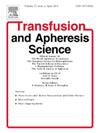Multi-disciplinary evaluation of blood donation practices and knowledge among medical graduates
IF 1.2
4区 医学
Q4 HEMATOLOGY
引用次数: 0
Abstract
Background
Medical graduates serve as forefront of healthcare workforce, and their knowledge and practices regarding voluntary blood donation (VBD) can significantly influence the future approach to blood donation and transfusion in the general population. This cross-sectional survey aims to evaluate the awareness and attitudes regarding VBD in the medical graduates and residents across multiple healthcare disciplines (allopathy, ayurveda and homeopathy). It also aims to evaluate the sociodemographic factors that may secondarily influence VBD in this subpopulation.
Materials and methods
This cross-sectional survey was conducted over a 6-month period across 2 allopathic (government and municipal), 1 homeopathic and 1 ayurvedic hospitals and included medical interns and residents at these institutions. Data was collected electronically using Google Forms™ and results were analyzed using SPSS version 25 (IBM, New York, USA).
Results
Data collected from 416 medical graduates (48.8 % allopathy, 31.3 % homeopathy, 20 % ayurveda), revealed that while 98.8 % recognized blood donation as essential, only 39.2 % donated regularly. Key barriers included perceived unfitness (30 %) and fear of needles (4.8 %). Awareness gaps were evident, with only 47.4 % receiving formal training and 57.5 % unaware of rare donor registries. Gender differences showed males donated more frequently (65.6 % vs. 40.5 %, p < 0.0005).
Conclusion
Medical graduates across all healthcare disciplines face gaps in knowledge, attitudes, and practices regarding VBD, driven by misconceptions and limited training. Targeted education and institutional support are vital to enable them as advocates and active participants in sustaining blood donation efforts within the general population.
医学毕业生献血实践和献血知识的多学科评价
医学毕业生是医疗保健工作者的前沿,他们关于自愿献血(VBD)的知识和实践可以显著影响未来一般人群的献血和输血方法。本横断面调查旨在评估跨多个医疗保健学科(对抗疗法、印度草药疗法和顺势疗法)的医学毕业生和住院医生对VBD的认识和态度。它还旨在评估可能在这一亚人群中继发影响VBD的社会人口因素。材料和方法本横断面调查在2家对抗疗法医院(政府和市政)、1家顺势疗法医院和1家阿育吠陀医院进行,为期6个月,调查对象包括这些机构的实习医生和住院医生。使用谷歌Forms™电子收集数据,并使用SPSS version 25 (IBM, New York, USA)对结果进行分析。结果416名医学毕业生(对抗疗法48.8% %,顺势疗法31.3% %,阿育韦达20. %)的数据显示,98.8% %的人认为献血是必需的,只有39.2% %的人定期献血。主要障碍包括感觉不健康(30% %)和害怕针头(4.8% %)。认识上的差距很明显,只有47.4% %接受过正式培训,57.5% %不了解罕见捐赠者登记。性别差异显示男性捐献频率更高(65.6% % vs. 40.5% %,p <; 0.0005)。结论:由于误解和培训不足,所有医疗保健学科的医学毕业生在VBD的知识、态度和实践方面都存在差距。有针对性的教育和机构支持对于使他们能够在一般人群中倡导和积极参与持续献血工作至关重要。
本文章由计算机程序翻译,如有差异,请以英文原文为准。
求助全文
约1分钟内获得全文
求助全文
来源期刊
CiteScore
3.60
自引率
5.30%
发文量
181
审稿时长
42 days
期刊介绍:
Transfusion and Apheresis Science brings comprehensive and up-to-date information to physicians and health care professionals involved in the rapidly changing fields of transfusion medicine, hemostasis and apheresis. The journal presents original articles relating to scientific and clinical studies in the areas of immunohematology, transfusion practice, bleeding and thrombotic disorders and both therapeutic and donor apheresis including hematopoietic stem cells. Topics covered include the collection and processing of blood, compatibility testing and guidelines for the use of blood products, as well as screening for and transmission of blood-borne diseases. All areas of apheresis - therapeutic and collection - are also addressed. We would like to specifically encourage allied health professionals in this area to submit manuscripts that relate to improved patient and donor care, technical aspects and educational issues.
Transfusion and Apheresis Science features a "Theme" section which includes, in each issue, a group of papers designed to review a specific topic of current importance in transfusion and hemostasis for the discussion of topical issues specific to apheresis and focuses on the operators'' viewpoint. Another section is "What''s Happening" which provides informal reporting of activities in the field. In addition, brief case reports and Letters to the Editor, as well as reviews of meetings and events of general interest, and a listing of recent patents make the journal a complete source of information for practitioners of transfusion, hemostasis and apheresis science. Immediate dissemination of important information is ensured by the commitment of Transfusion and Apheresis Science to rapid publication of both symposia and submitted papers.

 求助内容:
求助内容: 应助结果提醒方式:
应助结果提醒方式:


